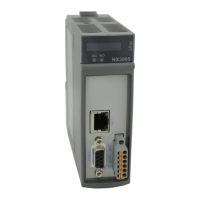6. REDUNDANCY WITH NX3030 CPU
On the other hand, the previous examples of modifications imply the direct representation %I and %Q variables allocation
for diagnostics, inputs and outputs similar to discussed in step 3 from the previous planning for hot modifications which affect
the PROFIBUS network (see Step 3 – Allocate %I and %Q Variables Areas for the PROFIBUS Network considering Future
Remote Expansion).
This way, at inserting the NX5000 module, or an I/O Ethernet or Serial driver, the allocation of the 3 following areas must
be planned for the inserted device:
%I variables area for inputs
%Q variables area for outputs
%Q variables area for diagnostics
The Step 3 – Allocate %I and %Q Variables Areas for the PROFIBUS Network considering Future Remote Expansion
section shows an example of group allocation of these areas, including PROFIBUS networks and an I/O driver (MODBUS
TCP server).
6.5.7.3. Incompatibility of Applications
If the areas to be used in the future not be planned properly, the redundant memory areas may have to be altered, thus
generating an incompatibility between the applications. This will result in only on PLC to remain in the Active state, with the
other PLC remaining Inactive, without the possibility of synchronizing redundant data or application between the two PLCs.
This incompatibility is informed by the redundancy diagnostics at:
DG_NX4010.tRedundancy.RedDgnLoc.sGeneral_Diag.bApplicationIncompatible.
This diagnostic is active when the download of a new application is done to one of the PLCs, usually the Non-Active, with
one of the following changes:
Changes in the redundant memory areas, configured in the parameters of the NX4010 module
Changes (create or remove) in the symbolic redundant variables, declared in redundant POUs or redundant GVLs
It is important to stress that, to make changes in symbolic redundant variables, the incompatibility problem will occur only
if a new application download is done to one of the PLCs. In case that the modifications in symbolic redundant variables, and
all the other modifications made in the project, fit into the group of Modifications which Allow Online Download, it’s possible
to do an Online Download of Modifications with no generation of incompatibility of applications between the PLCs.
6.5.7.4. Project Update due to MasterTool IEC XE Update
The MasterTool IEC XE programming tool is under a constant enhancement process, improving its features and adding
new ones. When it is necessary to update the tool in a redundant system, the used project also needs to be updated. This update
is done through the Project/Project Update menu, available in the tool. After updating the project, the Offline download
without Process Control Interruption can be done.
6.5.7.4.1. Updating Project from Versions Previous to 2.00 to version 2.00 or Higher
Among the MasterTool IEC XE version changes there is a special case that must be planned more carefully to avoid
stopping the process. The update of a project created with a version prior to 2.00 of the MasterTool IEC XE to version 2.00 or
higher causes a reconfiguration in the area allocated for the Persistent Variables object. This reconfiguration was implemented
aiming at optimizing the allocation of this area. However, if this object is present and marked as redundant in a project, this
reconfiguration won’t allow the data to be synchronized between the two project, always setting one of the Half-Cluster in
Inactive State.
This way, if this situation happens, the NX3030 CPU software can detect it and stop the synchronization of the Persistent
Variables object data until the two Half-Clusters’ projects are the same, and, therefore, are using a project with the updated
MasterTool IEC XE version. This situation won’t stop the process, but if a correct update sequence is not followed, the data of
the Persistent Variables object can be restarted.
In this case, the Offline Download sequence below must be followed:
Change the Half-Cluster in Active state project, unmarking the PersistentVars object inside the Redundancy Configura-
tion object. This download must be done as an Online change and for this to happen another change in the project must
be done, e.g. declaring a new variable inside the NonSkippedPrg POU
After the Online change, it’s necessary to run the command Create Boot Application while online, with the PLC in Active
state. This is necessary so that the application is synchronized with the Half-Cluster that passed to Not-Configured state
after the download
Update the project from version lower than 2.00 to version 2.00 or higher through the Project/Project Update menu in
MasterTool IEC XE
327

